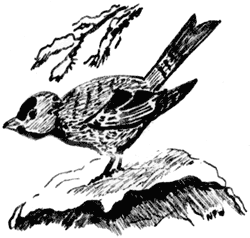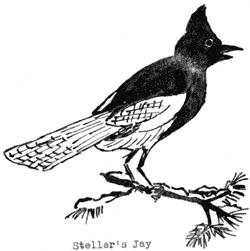Rosy Finches
By Dr. R. R. Huestis, Ranger-Naturalist
 This notice is very often followed, when opportunity comes, by a question directed to a member of the park personnel. Even when visitors have heard of rosy finches they do not realize that, at last, they have seen one. This is because the vernacular name is inappropriate and, at least in Crater Lake National Park, these birds are not restricted to high altitudes. Visitors notice particularly the grey head and the large size for a finch. The usual comment is that the rest of the bird looked brown.On July 8, the members of a guided trip up the Garfield Peak trail were able to closely observe a pair of Hepburn’s rosy finches. The birds were feeding along a receding snowbank at 7800 feet, about twenty feet from the trail and paid no attention to the fifteen observers although these latter were quieter than any group of people unaccustomed to the conventions of successful bird observation. It is this tendency to continue with the business of feeding, as though observers did not exist, that brings the Leucosticte particularly to the notice of individuals who have taken advantage of self-guiding trails and are fortunate enough to come in contact with these handsome and by no means well-known birds.
This notice is very often followed, when opportunity comes, by a question directed to a member of the park personnel. Even when visitors have heard of rosy finches they do not realize that, at last, they have seen one. This is because the vernacular name is inappropriate and, at least in Crater Lake National Park, these birds are not restricted to high altitudes. Visitors notice particularly the grey head and the large size for a finch. The usual comment is that the rest of the bird looked brown.On July 8, the members of a guided trip up the Garfield Peak trail were able to closely observe a pair of Hepburn’s rosy finches. The birds were feeding along a receding snowbank at 7800 feet, about twenty feet from the trail and paid no attention to the fifteen observers although these latter were quieter than any group of people unaccustomed to the conventions of successful bird observation. It is this tendency to continue with the business of feeding, as though observers did not exist, that brings the Leucosticte particularly to the notice of individuals who have taken advantage of self-guiding trails and are fortunate enough to come in contact with these handsome and by no means well-known birds.
Actually, under field observation Leucostictes do not look rosy. According to Webster rosy means blooming; blushing; resembling a rose, and none of these connotations fits a hard working brown and grey finch busily working the snow banks. These finches are not large birds but they are bigger than the more commonly seen juncos, siskins, crossbills, and purple finches, and perhaps look bigger than they are because they are clearly seen against the snow.
No part of Crater Lake National Park is above 9000 feet but because snow commonly lies late in the angle which the rim makes with the lake shore and in sheltered points on the rim walls, Leucostictes may be seen along the lake shore at 6200 feet, along the crater wall trail which joins the rim at 7000 feet, and even just within the rim in the parking areas. Their visits to these latter points are transitory but to step from one’s car and only have to walk a few feet to see rosy finches is quite an event even if it doesn’t happen very often.
Birds of the Park in Winter
By Dr. G. C. Ruhle, Park Naturalist
It has long been held that the waxing and waning of food supply has been the chief cause of the migration of birds, but soon after the task of rearing a brood has been completed, scarcely after the last migrants have arrived in the park for the short summer season, and at a time when available food is most abundant with some species, the parent birds have grown restive and have started their long journey to climes with happier winters. By the time snow blankets the ground with a durable mantle, a dozen of the more than a hundred species of park birds remain to endure the icy winds, long snow storms, and drab days of the high mountain fastness. And of these, few individuals are seen by the ranger or skier who visits the park and enters the forest solitudes. Not one winter visitant species has been reported in the park.
 Closely related to the nutcracker is the Oregon or gray jay, the local representative camp robber or whiskey jack. This bird is bold and friendly, so most campers make its acquaintance. Its general appearance is unkempt, quite in contrast to the natty nutcracker, but this fluffiness helps to protect it from wintry cold. Like the other crows and jays, it nests early, in weather seemingly cold enough to freeze. On a trip by Sno-cat westward from the Watchman, we discovered its nest high under a protective canopy of green hemlock boughs. It was of twigs, moss, and lichen, snugly lined with grass and feathers, and deep enough so that only the head and tail of the brooding bird protruded.Best known of all park birds is the Clark nutcracker of intimate association with timberline forests of our West and with visitors to the lake rim in the summertime. He fares well at all times, since he eats a great variety of food, tho the seeds of conifers are his particular fare. In winter, he loiters around the park mess house, watchful for scraps of food and a possible handout. Most interesting is the fact that this gray crow, who spends his whole life in high mountains, nests in the dead of winter. The young are active and on the wing long before the flow of visitor traffic is underway in June.
Closely related to the nutcracker is the Oregon or gray jay, the local representative camp robber or whiskey jack. This bird is bold and friendly, so most campers make its acquaintance. Its general appearance is unkempt, quite in contrast to the natty nutcracker, but this fluffiness helps to protect it from wintry cold. Like the other crows and jays, it nests early, in weather seemingly cold enough to freeze. On a trip by Sno-cat westward from the Watchman, we discovered its nest high under a protective canopy of green hemlock boughs. It was of twigs, moss, and lichen, snugly lined with grass and feathers, and deep enough so that only the head and tail of the brooding bird protruded.Best known of all park birds is the Clark nutcracker of intimate association with timberline forests of our West and with visitors to the lake rim in the summertime. He fares well at all times, since he eats a great variety of food, tho the seeds of conifers are his particular fare. In winter, he loiters around the park mess house, watchful for scraps of food and a possible handout. Most interesting is the fact that this gray crow, who spends his whole life in high mountains, nests in the dead of winter. The young are active and on the wing long before the flow of visitor traffic is underway in June.
Crows and jays are the most intelligent of birds and many provide for lean months by hiding provender in times of abundance. In summertime, it is entertaining to watch nutcrackers thriftily cache peanuts and tidbits supplied by kind people on the rim, only to have the Steller jay lurk in the shadows to steal them from under his nose. For this handsome character of dark blue suit, black cowl, and jaunty crest, like many other jays, is an ungracious rogue always ready to cry an indignant, “Thief, thief!”, at the other fellow, is a self-righteous termagant skilled in vituperation that bristles with vilest of epithets and curses. He mixes freely with the blameless nutcrackers and camp robbers that come to our camp in winter squawking, “We’re hungry; how about some grub?” For the smoke hardly starts curling above our lonely showshoe cabin, before these forms appear in the trees or on the snow, where no life had been visible upon the arrival of the occupant.
Holding aloof from his three cousins above, as well as from members of his own kind, the big, solitary raven may sometimes be seen flying inside of the crater wall in any month of the year. He loiters, scolding around the garbage disposal area, or lurks at a distance from the mess hall. In the park, as elsewhere, he undoubtedly finds carcasses of victims of the storm, and he carries out his beneficial role of scavenger. Ravens nest early. The crags inside the rim furnish them with an abundance of nesting sites.
The biggest park bird is the bald eagle. Formerly very abundant in Oregon, this, our national emblem, has become uncommon. He is to be seen, winter and summer, soaring over the lake; perhaps his favorite item of food is fish, either, fresh or carrion. Eagles nest on Wizard Island; building a huge home of stick and twigs, with a lining of moss and plant materials.
The great horned owl is so-called from the prominent tufts of feathers that project above his eyes. He is an aggressive night hunter that lives on rabbits, squirrels, grouse, and other prey. A hardy bird, he nests early, sometimes taking over the empty homes of a raven or hawk. His penetrating hoot, an unforgettable nocturnal sound of western timberland, is heard, also, in winter months blended with the wail of winds and the creaking of trees.
Occasionally on ski trips in the park, one is startled by a sudden whirr of laboring wings, as one flushes a sooty grouse. These birds perform interesting tho limited seasonal migrations. They spend summer and fall on open ridges to feed on ripe berries and insects. In spring, they move downward to the edges of the meadows to nest. In winter, they keep to heavy timber, mostly unseen and high in the conifers, in which they feed on buds and needles. In March, males utter a low-pitched hoot which comes from a throat inflated until large brilliant yellow sacs show on either side of the neck. The birds are ventriloquists, and one scrutinizes with care, only to find, if lucky, that the performer perches at the very elbow of the searcher.

